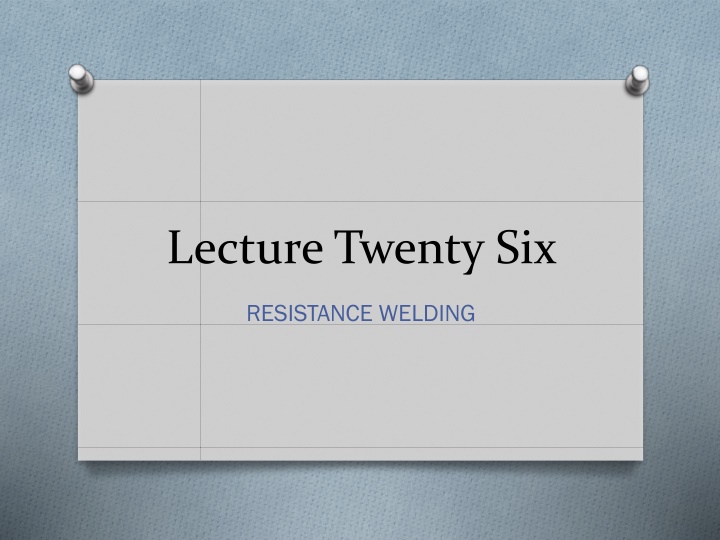
Understanding Resistance Welding Process in Fusion Welding
Learn about resistance welding (RW), a fusion welding process using heat and pressure generated by electrical resistance. Explore the components, power source, and operations involved in resistance welding for effective coalescence of workpieces without the need for shielding gases or filler metals.
Download Presentation

Please find below an Image/Link to download the presentation.
The content on the website is provided AS IS for your information and personal use only. It may not be sold, licensed, or shared on other websites without obtaining consent from the author. If you encounter any issues during the download, it is possible that the publisher has removed the file from their server.
You are allowed to download the files provided on this website for personal or commercial use, subject to the condition that they are used lawfully. All files are the property of their respective owners.
The content on the website is provided AS IS for your information and personal use only. It may not be sold, licensed, or shared on other websites without obtaining consent from the author.
E N D
Presentation Transcript
Lecture Twenty Six RESISTANCE WELDING
Resistance welding (RW) is a group of fusion-welding processes that uses a combination of heat and pressure to accomplish coalescence, the heat being generated by electrical resistance to current flow at the junction to be welded. The principal components in resistance welding are shown in Figure 26.1 for a resistance spot-welding operation, the most widely used process in the group. The components include workparts to be welded (usually sheet metal parts), two opposing electrodes, a means of applying pressure to squeeze the parts between the electrodes, and an AC power supply from which a controlled current can be applied. The operation results in a fused zone between the two parts, called a weld nugget in spot welding.
By comparison to arc welding, resistance welding uses no shielding gases, flux, or filler metal; and the electrodes that conduct electrical power to the process are nonconsumable. RW is classified as fusion welding because the applied heat almost always causes melting of the faying surfaces. However, there are exceptions. Some welding operations based on resistance heating use temperatures below the melting points of the base metals, so fusion does not occur.
POWER SOURCE IN RESISTANCE WELDING The heat energy supplied to the welding operation depends on current flow, resistance of the circuit , and length of time the current is applied . This can be expressed by the equation 26.1 H = I 2. R. t where H = heat generated, J (to convert to Btu divide by 1055); I = current, A; R = electrical resistance, V; and t = time, s.
The current used in resistance welding operations is very high (5000 to 20,000 A, typically), although voltage is relatively low (usuallybelow10V). The duration t of the current is short in most processes, perhaps lasting 0.1 to 0.4 s in a typical spot-welding operation. The reason why such a high current is used in RW is because (1) the squared term in Eq. (30.3) amplifies the effect of current, and (2) the resistance is very low (around 0.0001 V). Resistance in the welding circuit is the sum of (1) resistance of the electrodes, (2)resistances of the workparts,(3)contact resistances between electrodes and workparts, and (4) contact resistance of the faying surfaces. Thus, heat is generated in all of these regions of electrical resistance.
The ideal situation is for the faying surfaces to be the largest resistance in the sum, since this is the desired location of the weld. The resistance of the electrodes is minimized by using metals with very low resistivities, such as copper . Also , the electrodes are often water cooled to dissipate the heat that is generated there. The workpart resistances are a function of the resistivities of the base metals and the part thicknesses. The contact resistances between the electrodes and the parts are determined by the contact areas (i.e., size and shape of the electrode) and the condition of the surfaces (e.g., cleanliness of the work surfaces and scale on the electrode). Finally, the resistance at the faying surfaces depends on surface finish ,cleanliness ,contact area ,and pressure. No paint, oil,dirt , or other contaminants should be present to separate the contacting surfaces.
Example A resistance spot-welding operation is performed on two pieces of 1.5- mm-thick sheet steel using 12,000 A for a 0.20 s duration. The electrodes are 6 mm in diameter at the contacting surfaces. Resistance is assumed to be 0.0001 V, and the resulting weld nugget is 6 mm in diameter and 2.5 mm thick. The unit melting energy for the metal Um= 12.0J/ mm3. What portion of the heat generated was used to form the weld nugget, and what portion was dissipated into the work metal, electrodes, and surrounding air?
The heat required to melt this volume of metal is Hw=70.7(12.0)= 848J.The remaining heat, 2880- 848=2032J (70.6%of the total),is lost into the work metal ,electrodes , and surrounding air. In effect, this loss represents the combined effect of the heat transfer factor f1 and the melting factor f2. Success in resistance welding depends on pressure as well as heat. The principal functions of pressure in RW are to (1) force contact between the electrodes and the workparts and between the two work surfaces prior to applying current , and(2)press the faying surfaces together to accomplish coalescence when the proper welding temperature has been reached.






















